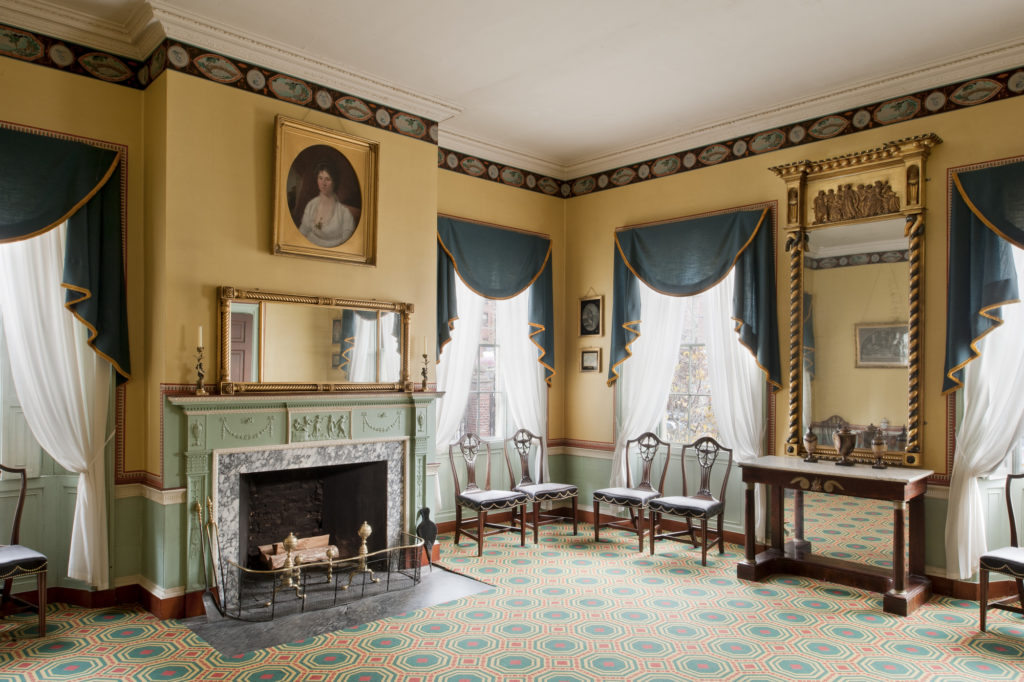 Otis House
Otis House
Parlor
Airs and Graces: A Retreat for Special Occasions
The parlor was a room reserved for entertaining and the Otises spent quite a bit of money to decorate it in the latest style. To a guest, this room would have seemed worlds away from the type of rooms found in most Boston homes in the late 18th century – typically small, wooden buildings with low ceilings and very few rooms. Items like wall-to-wall carpeting, curtains, and fancy upholstered furniture were expensive. Because this room was so impressive, the Otises took good care of it by protecting it when it was not in use. Between parties, the shutters were closed to keep sunlight from fading expensive textiles and the furniture was pushed back against the wall.
In this room the Otises would have received visitors, served tea, and played cards. Their servants would have been instructed to set up the room accordingly, before the guests were to arrive.
Restoring the Parlor
The Tea PartyThe Tea Party
To help with the restoration of this room Historic New England looked very closely at a painting “The Tea Party” by Boston artist Henry Sargent. The painting depicts a tea party about 1824 and provides a great deal of information about the furnishings, costume and social mores of the era. The opulent interior features wall-to-wall carpeting, fine furniture of the latest taste, and women in stylish Empire gowns.
Tea parties were often early evening events that were less formal than a dance and were a way to entertain a large group of people without having to serve a full dinner. Room use was very flexible during the Federal era, and light, wooden furniture on casters was often rearranged to make conversational and intimate groupings during such an event.
Henry Sargent, American, 1770–1845
The Tea Party, about 1824
Oil on canvas
163.51 x 133.03 cm (64 3/8 x 52 3/8 in.)
Museum of Fine Arts, Boston
Gift of Mrs. Horatio Appleton Lamb in memory of Mr. and Mrs. Winthrop Sargent
19.12
Photograph copyright 2020 Museum of Fine Arts, Boston
Casters are small wheels attached to furniture legs, making it portable and easier to move around.
Imported wall-to-wall carpet was a luxury reserved for the wealthy in the Federal period and often the most expensive item in a house.
Dresses with Empire waists were popular in this period, with colored dresses worn to daytime and early evening events.
to learn more
Neoclassical Design
Parlor MantleThe Parlor Mantle
Federal era design was greatly influenced by the classical civilizations of Rome and Greece. In 1738, the Roman city of Pompeii was re-discovered, and excavations there received great attention in Europe and America. Motifs and designs were copied from Pompeii and were soon found in American decorative settings. Most of the ornament in the Otis House is neoclassical. On the fireplace mantle, for example, urns, flower garlands, and classically dressed figures can all be found.

The border at the top of the wall paper is called “Scenes from Pompeii,” and the carpet is reminiscent of Pompeian tiles. Even the bright colors on the walls were copied from Pompeian villas. In America, this fascination with ancient Rome spread into the political arena as well. After the American Revolution, Americans began creating new systems of government based on the republican governments of ancient Greece and Rome.
Restoring the Parlor
Wallpaper, Carpet, and Paint
Wallpaper
In the 1916 examination of the Otis House parlor, no Federal era wallpaper remains were found on the walls. For both the parlor or dining room, curators chose to use plain papers with wallpaper borders. Rooms decorated with solid colored wallpaper, called “plain papers”, and embellished with a wide variety of colorful borders were fashionable in the period when Otis House was built. The border in this room is a reproduction of a paper from Montpeiler, the home of Revolutionary War hero, Henry Knox, in Thomaston, Maine. This was a logical choice as Knox was a contemporary of Otis and his house was likely designed by Charles Bulfinch, in 1794. This particular French paper was titled “Scenes from Pompeii”. The discovery and excavation of Roman ruins at Herculaneum and Pompeii beginning in 1738 were made fashionable in England through the designs of the architect Robert Adam and influenced American Neoclassical style. The bright yellow paper set off the bold border and created a striking visual effect in concert with the paint and wall-to-wall carpet.
Carpet
Removal of Victorian carpets in this room revealed unfinished pine boards commonly used under wall-to-wall carpeting. In the Federal era, urban households, especially wealthy ones like the Otises, were likely to possess carpets. By 1790, classically inspired carpets had become popular and this reproduction carpet imitates a Roman tile floor.
Paint
Determining the original paint colors for the room required scientific analysis and involved taking samples from areas where the paint was thickest and then analyzing them chemically and microscopically. Most rooms in the house were painted with variations of a light bluish-green color (note the trim and wall below the chair rail in the picture above) with detail picked out in white.
